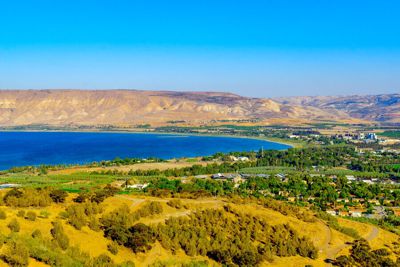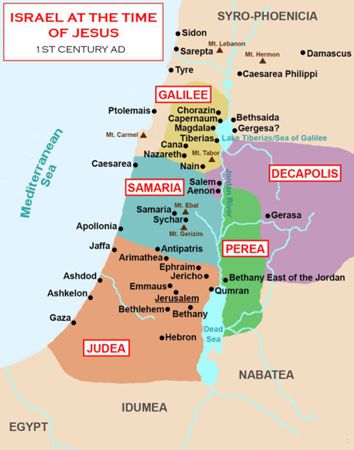Darkness and light in Galilee
 Light is defined as the electromagnetic radiation with wavelengths between 380 and 750 nm, which is visible to the human eye. This light is a source of illumination. And sunlight provides the energy that green plants use to create sugars mostly in the form of starches, which release energy into the living things that digest them. This process of photosynthesis provides virtually all the energy used by living things. Darkness is the absence of visible light.
Light is defined as the electromagnetic radiation with wavelengths between 380 and 750 nm, which is visible to the human eye. This light is a source of illumination. And sunlight provides the energy that green plants use to create sugars mostly in the form of starches, which release energy into the living things that digest them. This process of photosynthesis provides virtually all the energy used by living things. Darkness is the absence of visible light.
The provinces of ancient Palestine were Galilee (north), Samaria (central), and Judea (south) (Acts 9:31). When speaking Aramaic, Galileans had a different accent to the Judeans (Mt. 26:73). Galilee was part of the northern kingdom of Israel when it was separate from the kingdom of Judah. Galilee was divided into two parts – upper Galilee (which is mountainous and known as “Galilee of the Gentiles”) to the north and lower Galilee to the south.
The Jordan River and the sea of Galilee form the eastern boundary of Galilee. The sea of Galilee is the lowest freshwater lake on Earth at 210m (690 ft) below sea level. It’s about 100 km (60 miles) north of Jerusalem, the capital of Israel.
Darkness
During Israel’s monarchy, Galilee was a buffer zone between Israel and Aram (Syria). So, Galilee was targeted in enemy attacks from the north.
The book of Isaiah contains the prophet’s message to Judah. They faced judgement because of their rebellion against God. The Assyrians were to inflict judgment on Israel and Judah. It’s a gloomy situation because the land will be devastated.
But then Isaiah says, “Nevertheless, there will be no more gloom for those who were in distress. In the past he [God] humbled the land of Zebulun and the land of Naphtali, but in the future, he will honor Galilee of the nations, by the Way of the Sea, beyond the Jordan—The people walking in darkness have seen a great light; on those living in the land of deep darkness a light has dawned.” (Isa. 9:1-2NIV).
In this passage “darkness” is a metaphor for gloom and distress and “light” is a metaphor for honor. This literary technique occurs often in the book of Isaiah and in the Bible (Appendix A and B).
Indeed there was distress at that time in the lands of Zebulun and Naphtali because of military threats. These tribes were the heartland of Galilee (Josh. 19:10-18, 32-39). Then in 733BC, the Assyrians captured Galilee (2 Ki. 15:29), and in 722BC they captured the kingdom of Israel. So, the prophecy of judgment was fulfilled.
It was called “Galilee of the Gentiles (or nations)” because of the mix of races. The Israelite tribes in this region were unable to completely expel the original Canaanite inhabitants – there were still Canaanites in Naphtali (Jud. 1:33). And the Assyrians deported Israelites to Assyria and resettled Gentiles in Galilee (2 Ki. 15:29; 17:24). So, it was a racially mixed area.
But someday Galilee of the Gentiles, the way of the Sea (the ancient road from Damascus to Egypt that passed through Galilee) and the eastern side of the Jordan (the Decapolis) would be honored. It offers hope to “the land of deep darkness”. There will be honor and a “great light”. What does this refer to?
With hindsight we can see that the remainder of Isaiah 9 describes the first (v.6a) and second (v. 3-5, 6b-7) advents of Christ. So, Jesus Christ is the great light that brought honor to Galilee.
Light
Matthew quoted the passage from Isaiah 9,
‘12 When Jesus heard that John had been put in prison, He withdrew to Galilee. 13 Leaving Nazareth, He went and lived in Capernaum, which was by the lake in the area of Zebulun and Naphtali— 14 to fulfill what was said through the prophet Isaiah: 15 “Land of Zebulun and land of Naphtali, the Way of the Sea, beyond the Jordan, Galilee of the Gentiles—16 the people living in darkness have seen a great light; on those living in the land of the shadow of death a light has dawned.”
17 From that time on Jesus began to preach, “Repent, for the kingdom of heaven has come near”’ (Mt. 4:12-17).
So, Jesus was the metaphorical light predicted by Isaiah. Most of the events in Christ’s life took place in Galilee. Joseph and Mary lived in Nazareth in lower Galilee. The village of Nazareth was in Zebulun, and the town of Capernaum was in Naphtali. Jesus lived in Nazareth (Mt. 2:23) and later he moved to Capernaum (Mt. 4:13).
Before Christ’s ministry, the people in Galilee were living in the darkness, meaning without Christ and without the gospel truth. But then John the Baptist prepared the way and was followed by Christ who healed and taught the people about the kingdom of God. Jesus returned to Galilee after John the Baptist was arrested (Mt. 4:12; Mk. 1:14; Jn. 4:1-3).
 Jesus did most of His ministry in Galilee. 11 of the 12 disciples were from Galilee (Judas was Judean). At the ascension they were told, “Men of Galilee, … why do you stand here looking into the sky? This same Jesus, who has been taken from you into heaven, will come back in the same way you have seen Him go into heaven” (Acts 1:11). And many of the women who followed and helped Jesus came from Galilee (Mt. 27:55). So Christ’s ministry was predominately amongst the common people in Galilee than the amongst community leaders (political, religious and academic) in Jerusalem.
Jesus did most of His ministry in Galilee. 11 of the 12 disciples were from Galilee (Judas was Judean). At the ascension they were told, “Men of Galilee, … why do you stand here looking into the sky? This same Jesus, who has been taken from you into heaven, will come back in the same way you have seen Him go into heaven” (Acts 1:11). And many of the women who followed and helped Jesus came from Galilee (Mt. 27:55). So Christ’s ministry was predominately amongst the common people in Galilee than the amongst community leaders (political, religious and academic) in Jerusalem.
There was no expectation that the Messiah would come from Galilee. The Jewish religious leaders thought “you will find that a prophet does not come out of Galilee.” (Jn. 7:52). But they were wrong, the prophet Jonah came from Gath Hepher in Galilee (Jon. 1:1; 2 Ki. 14:25; Josh. 19:10, 13). Gath Hepher was about 5 km (3 miles) from the future site of Nazareth (Wright, 2012).
And Nathanael who was from Cana in Galilee said, “Can anything good come out of Nazareth?” (Jn. 1:46; 21:2). So, some areas of Galilee were looked down on. This matched the fact that Jesus was despised.
Lessons for us
Galilee was transformed from metaphorical darkness to metaphorical light by Jesus. Galilee had been devastated by the Assyrian army, but it was honored by the ministry of the Messiah which brought joy and salvation.
Jesus is the only genuine source of spiritual light. Although the world is a dark place metaphorically, the good news about Jesus brings spiritual light. Have you begun your journey towards this light?
This metaphorical light should be evident today in the lives of Christians. If you are a Christian, are you following “the example of Christ” (1 Cor. 11:1)?
Christ’s focus on Galilee shows that Christianity flourishes more amongst the common people than the elite.
Appendix A: “Darkness” and “light” in Isaiah
The Hebrew word “light” (Strongs #216, “or”) occurs 26 times in the book of Isaiah. And the word “darkness” (Strongs #2822, “choshek”) occurs 14 times in Isaiah. The context of these instances was used to determine the meaning of the words.
On a few occasions they mean physical light and the absence of physical light. But the most common meaning was metaphorical:
“Light” – meaning good, joy, or salvation, and
“Darkness” – meaning evil, gloom, sin or judgment.
Appendix B: “Darkness” and “light” in the Bible
The words “darkness” and “light” occur together in about 55 verses of the Bible, 33 are in the Old Testament and 22 in the New Testament. About 60% of those in the Old Testament have a metaphorical meaning and 100% in the New Testament have a metaphorical meaning.
God is said to be light, “the Lord will be your everlasting light “ (Isa. 60:19). God is the spiritual light in a spiritually dark world.
And Jesus said, “I am the light of the world. Whoever follows me will never walk in darkness, but will have the light of life” (Jn. 8:12). And “I have come into the world as a light, so that no one who believes in me should stay in darkness” (Jn. 12:46). Jesus is the spiritual light in a spiritually dark world.
And Christians are told, “For you were once darkness, but now you are light in the Lord. Live as children of light (for the fruit of the light consists in all goodness, righteousness and truth) and find out what pleases the Lord” (Eph. 5:8-10). They are to be spiritual lights in a spiritually dark world.
Reference
Wright P H, 2012, “Rose then and now Bible map atlas”, Rose Publishing, p. 81.
Written, April 2024
This entry was posted on April 12, 2024 by George Hawke. It was filed under Christian, History and prophecy, Spiritual and was tagged with Christ, dark, darkness, Galilee, Israel, Jesus, light, metaphor.






Leave a comment